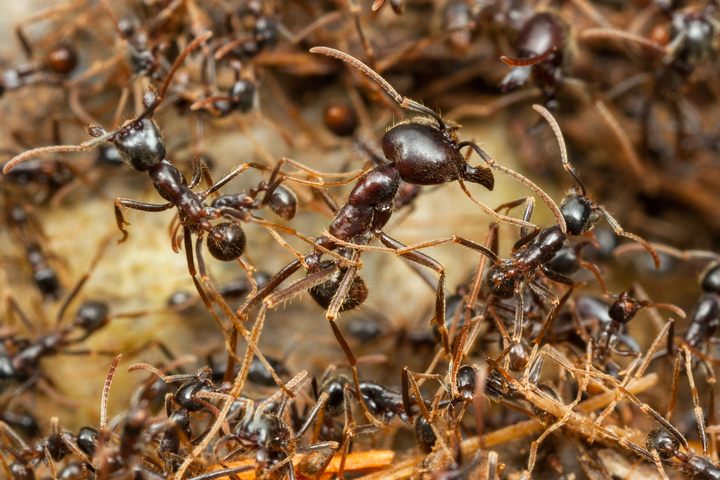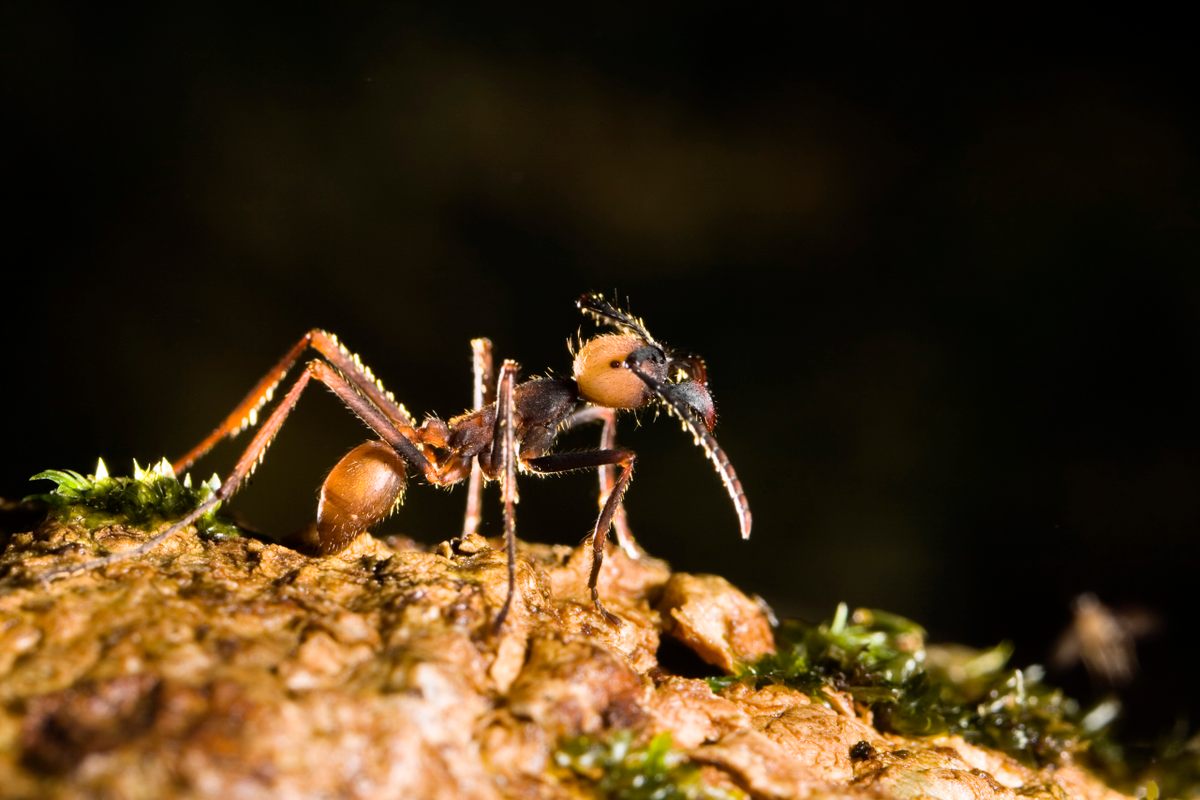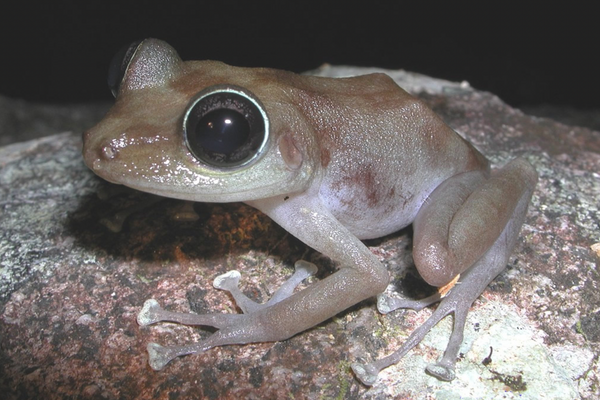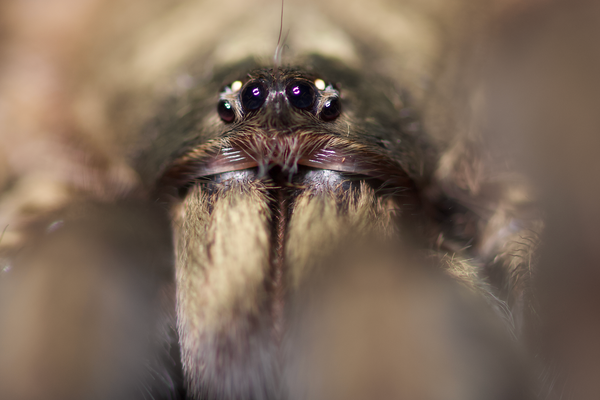
How a Lone Researcher Faced Down Millions of Army Ants on the March in Ecuador
Renowned entomologist Frank Nischk remembers when the determined insects tried to invade a field station.
Excerpted with permission from Of Cockroaches and Crickets: Learning to Love Creatures That Skitter and Jump, by Frank Nischk. Published February 2023 by Greystone Books. All rights reserved. Nischk is an entomologist and filmmaker whose fieldwork includes research at Reserva Otonga in the Ecuadorian Andes, where this story takes place.
One afternoon, I was sitting on the veranda at the small research station in the reserve. I was alone, because my botanical colleagues were busy with their work in the forest. I was sorting and preparing my collection: dried crickets, the fruits of two weeks’ work in the cloud forest. Then I heard a swell of rustling and murmuring, and knew immediately what was moving toward me.
The spectacular behavior of army ants means they have been very well researched. A large number of scientific publications cover their biology, and especially their ecological significance for other life-forms in tropical rainforests. The role they play in the interactions of the forest is truly astounding. Let’s stick with the military analogy. Every human army used to be accompanied by a huge number of civilians that traded with the soldiers. Craftspeople, bakers, and butchers all offered goods and services. There were thieves, scribes, battleground artists, translators, and much more. It’s very similar with army ants advancing on their prey. They are escorted by an entourage of life-forms looking to profit from the ants.
For over 50 years, American biologists Carl and Marian Rettenmeyer researched army ants and the creatures that followed them as they marched. The scientists sent their own army of undergraduate and postgraduate students to South America over the years. With every expedition, their list of animal species with a direct relationship to army ants grew. Up until his death in 2009, Carl Rettenmeyer collected more and more astonishing information about the ants he studied—after which his wife, Marian, completed his life’s work. The couple counted a total of 557 animal species whose fate depended to a greater or lesser extent on Eciton burchellii.

Over 200 species of birds were observed around army ant swarms in Central and South America, picking off the insects scared up by the six-legged warriors. Carl Rettenmeyer suspected that 29 of these species are regular followers of the army ants, making them true companion species to Eciton. These birds depend completely on the ants doing the laborious work of driving the insects they eat out of their hiding places. Many of these prey species hide in the leaf litter on the forest floor and come out only at night—unless the ants flush them out. Flocks of birds eat their fill as the ant army advances, taking some of the ants’ victims for themselves. Behavioral scientists call the ant birds’ strategy kleptoparasitism—freeloading through theft.
Army ants are not only accompanied by ant birds. A multitude of butterflies flutter around the ants’ feathered followers. The ant birds’ droppings are a nutritious, and therefore much sought-after, resource for the butterflies.
In the vicinity of the ant swarm, spider wasps, relatives of tarantula hawks, are on the lookout for spiders. Parasitic wasps and tiny flies lay their eggs and deposit their larvae on insects that came within a hair’s breadth of succumbing to the ant army. Other fly larvae feed off the victims the ants leave in their wake—frogs, for example, which the ants can kill with their sharp mouthparts but cannot cut up and carry away.
The biological research station in Otonga was a wonderful wooden building supported by eight thick posts about the height of a person. There were large rooms inside, including a dormitory where scientists and students could spend the night. At the time, there were five of us in the reserve. But I was alone as I waited for the ants to attack. I knew that the army ants are not interested in mammals and especially were not interested in me, an adult Homo sapiens. The ants are equipped with large cutting mouthparts shaped like shears. These do a great job of chopping hard-scaled insects into bite-sized pieces, but they are no good for cutting into the muscular flesh of mammals. The only things I was afraid for were our provisions and, most of all, the crickets I had so painstakingly collected as part of my thesis research. I therefore decided to confront the advancing army and defend the station against the ant invasion.

I looked around the research station. Were there any weapons I could use to ward off the impending attack? I decided on a wide broom with a long handle and positioned myself where one of the eight posts was attached to the building’s floor. I chose the post closest to the advancing ant army. My fears were realized. The army ants climbed the post as though it were an ancient tree. A stream of hard, small bodies welled up through the cracks in the floorboards like water in a flood. I began to sweep as thoroughly and as quickly as I could.
The list of life-forms with which E. burchellii is associated includes a few that are truly tiny. Some creatures take advantage of the fact that army ants build a kind of field camp—a bivouac—in a hollow tree trunk to house their brood and their queen. An Eciton colony goes through sedentary stages in the course of the year, during which the ants return home to the same bivouac every evening. The colony also goes through nomadic phases when the worker ants carry the larvae through the forest. Army ants on the move overcome obstacles such as small streams by forming a living bridge with their bodies.
Every evening in a nomadic stage, the huge ant colony sets itself up in a new bivouac. This type of accommodation is a paradise for mites. Some species sit on adult ants like eight-legged pimples and suck their hemolymph. Others parasitize the ant brood. Yet others fall on the waste that the Eciton worker ants take out to a kind of trash pile right next to their bivouac. The German ant researcher Stefanie Berghoff once counted the mites that live together with E. burchellii: about 20,000 of these little arachnids live as tenants in an army ant colony.
It’s also amazing how many species of insects—including a few beetles—manage to live safely in the middle of the bivouac of these insect-eating ants. The beetle species seem to share an unusual behavior. To avoid being eaten by the ants, they camouflage themselves—as ants. They copy the shape and color of their hosts; they also repeatedly touch the ants with their antennae, stealing some of the Eciton scent for themselves. The beetles rub themselves with the ant perfume and this grooming behavior then masks them chemically as well. Just in case the camouflage and “Eau de Eciton” fail them, most of the bivouac-dwelling beetles have an extremely flat, round exoskeleton, perfectly shaped so the mouthparts of the predatory ants cannot gain purchase; they simply slip off.
But why do the defenseless beetles put themselves in such danger by venturing right into the lion’s den? The answer is clear. The squatters are living in a land of plenty. A constant stream of worker ants keeps bringing new supplies of food for the ant brood from the forest to the bivouac. All the beetles need to do is help themselves. And that’s not all. As long as the beetles’ cover is not blown, the army ants’ bivouac is one of the safest places for otherwise-defenseless beetles to be. Thousands of soldier ants are defending their brood and, in so doing, are also unintentionally defending the beetles from attack.
More and more ants were streaming out of the cracks between the post and the floor. I speeded up my sweeping to return the creeping critters to whence they had just come. But no matter how hard I swept, the flow of ants just would not stop. I imagined the ants would soon take over the building as my muscles gradually started to burn. But then—relief. The rush of small bodies suddenly slowed, and the ever-diminishing numbers of invaders turned around as soon as they reached the floor. My heroic sweeping seemed to have made a lasting impression.
The most important means of communication for ants is scent. The ants attacked by the broom seemed to have left a chemical warning: “Danger! Squad retreat! Flee!”
Exhausted, I made myself a cup of coffee and sat down for a moment. My colleagues would never believe what I had just been through. But I had let down my guard too soon. A few minutes after I had seen off the first attack, the besieging forces were climbing post number two. Whether I wanted to or not, I had to grab my bristly weapon for a second time and continue sweeping.
Of the 557 animal species that researchers have observed near Eciton colonies, about 300—so Carl Rettenmeyer and his team estimated—are at least partially and temporarily dependent on the ants. The researchers described this as “the largest animal association centered on one species.” The authors of the study also warned: “The extinction of E. burchellii from any habitat over its vast area of distribution is likely to cause the extinction of numerous associated animals at that site.”
The swarm of army ants attempted to invade the small research station three more times. Every support post appeared to them to be yet another tree to be conquered for food. Every time I had to sweep like mad or surrender to the million-strong army of ants. At the end of the afternoon, when the last ant had realized that I was not going to give up, I rested against the wall of the building, completely exhausted. I was relieved that the storm had moved on. Luckily, I had brought a bottle of aguardiente, Colombian schnapps, along with me to Reserva Otonga. I sat down with the bottle in front of the building, took a long swig, and waited for dusk. I couldn’t help but think of a sentence from One Hundred Years of Solitude, a novel by the Colombian Nobel Prize winner Gabriel García Márquez: “The first of the line is tied to a tree and the last is being eaten by the ants.”
So reads the grim prophecy in Márquez’s novel, which prefigures the rise and fall of the Buendía family in the rainforest settlement of Macondo. In the end, it is indeed the ants that seal the family’s fate when they kill a newborn. I had always understood the gruesome ending of One Hundred Years of Solitude to be a fantastic exaggeration and a metaphor for what happens when you give up and let yourself go. In the Reserva Otonga, I revisited this thought. Now I understood why people who live in the forests of Ecuador regularly remove even small plants that grow under their dwellings. This lessens the likelihood of uninvited insect guests coming to visit.

That evening, I sat on the steps of the research station even longer than usual. As though to make it up to me, nature put on an unforgettable spectacle that night. Usually the reserve was swallowed by a cloud every morning and shrouded in thick fog for the remainder of the day. Not so on the evening of the ant attack. The clouds parted, opening up a view to the two craters of the twin Andean volcanoes, the Illinizas. It’ll probably sound like something out of a kitschy Hollywood movie, but on that evening, the first without a curtain of cloud since we had climbed up to the reserve, a full moon rose in the sky. Now, even though night was falling, it was brighter than during the foggy hours of the day. The moonlight woke cicadas and birds that I had otherwise heard only in daytime. Neon-green points of light flitted from tree to tree—fireflies in the mood for love looking for mates. I took another couple of sips of Colombian firewater.
At first tentatively, and then with increasing intensity, the moon changed color, its yellowy gold gradually turning blood red. Was the aguardiente working its magic? No. Not only had the curtain of cloud been drawn back, but now a special performance was playing out on the sky’s stage: an eclipse of the moon in the starry skies over the Andes,
The botanists were already asleep, likely dreaming of orchids, mosses, and ferns. I took a final sip of aguardiente and was happy to be exactly where I was right then.



































Follow us on Twitter to get the latest on the world's hidden wonders.
Like us on Facebook to get the latest on the world's hidden wonders.
Follow us on Twitter Like us on Facebook